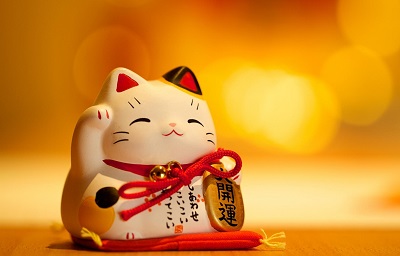Group Blog All Blog |
Engimono Engimono  Everyone wants tohave more luck than luck. The Japanese have a superstitious belief as well. Thefetish mascot, or "Japanese" called "Engimono", is believedby the Japanese to bring good fortune to those who hold it. There are variousstyles of mascots in Japan, from north to south. Meaning of lucky mascot thathas passed the generation version. Make believe that succession or symbol is agood meaning and give you a lot of luck. "Engimono" refers to a fetish orsymbolizing good fortune in such areas as making crops abundant.To do business.The family is healthy.
10popularJapanese lucky draw near or at home 1.Kowloon Fish(KOI Fish)
Carp or catfish It is a symbol that is very important in Japanand is highly regarded. We can see this fish circulating in swimming pools andtemples in general. Carp is a symbol of good humor, happiness and well-being.In addition, carp can swim upstream of rivers and streams, so it is a symbol ofcourage and determination. We can see the carp image on the men's kimono andduring the boys festival called "Tano no Sekku" held on May 5 everyyear. At every house with a boy hanging Koinobori (carp flag) in front of thehouse, sometimes we see a pair of carp on the roof of the castle called"Sachihoko". This twin carp is meant to be male and female. That isthe symbol of the integrity of life. 2. Frog (Kaeru)
Kaeru is a symbol that is believed to bring good luck. Kearuhas another meaning in Japanese, meaning "to come back". This is whythe frog is a symbol of the people who go far. The Japanese usually hang smallsymbols hanging on their luggage, handbags, etc. While traveling, they areconfident that they will return safely. 3. Owl (Fukurou)
Fukurou is the symbol of life. "Without difficulty"and "lucky to be coming", we often see ceramic pots, owls and statuesin the garden. It is believed that owls will protect them from hardship. Thereare various toy ornaments of owls being sold in many forms. 4. Maneki neko
Neko or Maneki Neko is usually made of ceramic, plastic andmetal, usually set in front of the store. There are many colors, such as red,black, white, black, etc. In a different attitude, but often is a popular stylein front of the store is a cat step on the left foot. By means of nurturingwealth and fortune, it is important to do good business. 5. Daruma Doll
Most Darunas are reddish with a man's face, with eyebrows andthick shoulders. It is believed in Japan that the luck of the sex. Doraemondolls are made from paper or ceramics, and they also bring luck, love, courageand power. These dolls are available in more than 5 different colors, each withdifferent meanings. Red means fortune and luck. Now blue for health andlongevity. Yellow is meant to protect and protect. Gold is wealthy and wealthy.In addition, white brings harmony and love. 6. Crane (Tsuru)
Tsurugi (Tsuru) can be seen in most Japanese paintings and isanother attraction for Japanese. Flamingos are often associated with New Year'sfestivities, weddings and other ceremonies. The wedding gin will have adecorative florist painting on the set. It is believed that folding crane paperwill make your wishes come true when you fold one thousand. 7. Daikokuten
Daikokuten (kubera) is believed to be the goddess of wealth inHinduism and Buddhism. Daikokuten's large and small statues are often kept athome and at shops, and are believed to symbolize prosperity and fortune.Daikokuten is also one of the seven gods of fate of Japan. 8. Hatyi (Hotei)
Hatyi (Hotei) is a Buddhist image with many gestures. It isalso made from a variety of raw materials, either metal or ceramic. Thecharacteristics are often seen. Hold the beads in one hand and the other handin the large shoulder bag, and gold in the sacred object, similar to the fatman, is believed to bring good fortune and good health to home and shoppers.Hoi is one of the seven gods of luck in Japan. 9. Fetish (Omamori)
Omamori is an amulet that is wrapped in Japanese silk andstuffed on paper or wood. Mamoru comes from the word guard in Japanese. We canfind Omamori. Variety of different colors and shapes. Can be bought by theshrine and measure almost everywhere. It is believed that Omamori brings goodfortune and sometimes has different names in different places and features,such as bringing safety, love, travel and so on. Go 10. Matsu
Matsu can be seen by most Japanese gardens. Pine trees arelush throughout the year, can be grown in all climates, it is a symbol oflongevity. In the new year, the "Kadomatsu" bamboo tree is being setup at the entrance of the office and temple to welcome the new year. There is afetish. Many sacred things in Japanese beliefs such as peony, cherry blossom,and so on. Some of the symbols are known only in the provincial area and varyin specific areas, and yet people will respect or use different mascots. Toeach area
|
สมาชิกหมายเลข 4743304
 ผู้ติดตามบล็อก : 1 คน [?] ผู้ติดตามบล็อก : 1 คน [?] Link |










